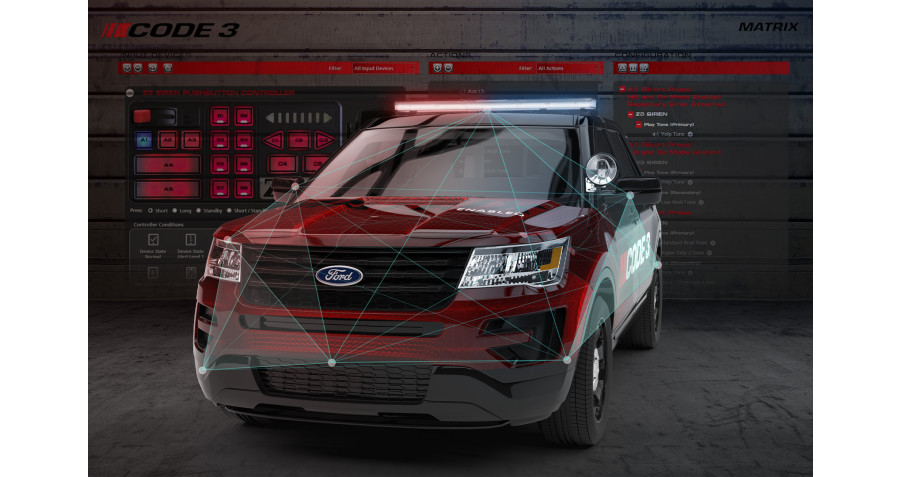Thinking Strategically About Emergency Lighting
Finding the right combination of colors, luminosity and flash patterns

In the last 80 years, remarkable innovations in emergency lighting have significantly improved first responder and public safety. A police officer in the 1940’s relied on his one red beacon and siren to warn other drivers to give way as he navigated his black-and-white Plymouth Special towards an emergency. Today, the lighting and warning device combinations are endless. Beyond traditional uses in public safety, emergency lighting can be installed on virtually any vehicle surface and on any platform, from golf carts to heavy-duty mining equipment. Bright and efficient LEDs available in multiple colors offer further customization. With all these innovations and options, emergency responders and operators need to think strategically about how to employ their lighting and warning systems. Code 3 has the technology and tools to assist.
Exploring Options and Opinions
Several studies and a pile of sometimes conflicting anecdotal evidence have surfaced in the last 20 years that recommend when, why, and how to use various flash patterns and color combinations to maximize visibility and minimize risk. Some focus on the technical aspects of light and the engineering solutions around lighting products. For example, most have recommended red lights for day-use and blue for use at night due to the wavelengths and the human eye’s capacity to see these colors in ambient light. White light tends to be the most visible at greater distances but may be too intense at shorter ones. The amount of power needed to see each color equally is another factor that can affect vehicle and systems operation.
Other studies have focused on the psychology of color and the behavioral aspects associated with emergency lights. We tend to associate red with stop or danger, amber/yellow means caution or obstruction, and blue can be perceived as motion coming towards the viewer. There is also color blindness to consider, which necessitates the use of two or more colors in lighting products. Some have even suggested that drivers can succumb to the “moth effect” and can be drawn towards bright, flashing lights. This has opened up a whole other debate about the purpose of emergency lighting: provide complete visibility or communicate a clear warning message.
The same technical, physiological, and psychological principles apply to flash patterns as well as the intensity of the light output. An especially fast pattern may not be perceived as clearly or worse, it may induce seizures in some people. A slow pattern may not convey the urgency of the situation. Randomization vs. a sequential pattern is yet another consideration. There are also complaints that modern LED technology is entirely too bright and intense, especially on clear nights. The “dazzling” effect can be distracting, cause temporary night blindness and even obscure emergency responder and victim visibility on scene.
More than One Correct Answer
Is there a “sweet spot?” Emergency responders and fleet managers have puzzled over the right combination of color, luminosity, and pattern for decades.
The debate continues and experts have made recommendations based on a variety of circumstances and conditions. Despite the rhetoric, however, appropriate emergency lighting is in the eye of the beholder. What works for a county ambulance fleet in a drier climate like Arizona may not be as effective for a division of SUVs patrolling the drenched, densely wooded roadways of the Pacific Northwest. Different jobs, different environments, different lighting strategies.
As additional field testing continues and preferences change, there are tools now available to customize solutions that works with your agency and community’s needs. Code 3’s Matrix system does not take sides and will help fleet managers design a lighting regime that provides enhanced visibility without compromising first responders’ safety.
Managing Options and Risk with Matrix
If temporary night blindness is a concern while officers are on traffic stops, use Matrix to adjust the flash pattern and luminosity. Change the colors to white/amber when the unit is in park. Need to maximize visibility while running code through an intersection? Program the white lights to activate when the horn is engaged. Beyond the lighting system, Matrix can also utilize the siren to efficiently manage audible warnings. With an interactive and intuitive interface, fleet managers can configure these patterns and more with simple click, drag, drop functionality.
A 2018 article in Police Chief Magazine summarizes how advanced technology like Matrix significantly improves operations and overall public safety:
“More and more departments are incorporating adaptive warning systems into their vehicles, automatically displaying what is appropriate for the given situation. The result is safer emergency vehicles and lower risks of injury, death, and property damage.”
Alleviating the burden of manual controls and protocols ultimately saves time while re-focusing the officer on the task at hand. This also allows the officer’s unit to automatically adapt to conditions on the road and at the scene. Although there is no one correct solution to the emergency lighting conundrum, find the right path forward for your department or agency with Matrix and Code 3’s line of serialized lighting and warning systems.
Works Referenced:
"Florida Highway Patrol Experimental Lighting Study" "Police Vehicle Warning Signals—An Innovative Approach to Officer Safety" "Seeing the Light" "Impacts of Flashing Emergency Lights and Vehicle-Mounted Illumination on Driver Visibility and Glare" "Reactions to Emergency Light Colors" "Towing the Line Between Warning Lighting Color" "Color Psychology in Marketing"
Blog